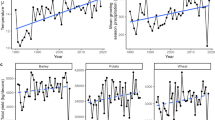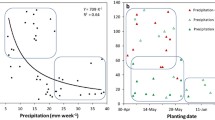Abstract
For the 1980–2003 period, we analyzed the relationship between crop yield and three climatic variables (minimum temperature, maximum temperature, and precipitation) for 12 major Californian crops: wine grapes, lettuce, almonds, strawberries, table grapes, hay, oranges, cotton, tomatoes, walnuts, avocados, and pistachios. The months and climatic variables of greatest importance to each crop were used to develop regressions relating yield to climatic conditions. For most crops, fairly simple equations using only 2–3 variables explained more than two-thirds of observed yield variance. The types of variables and months identified suggest that relatively poorly understood processes such as crop infection, pollination, and dormancy may be important mechanisms by which climate influences crop yield. Recent climatic trends have had mixed effects on crop yields, with orange and walnut yields aided, avocado yields hurt, and most crops little affected by recent climatic trends. Yield-climate relationships can provide a foundation for forecasting crop production within a year and for projecting the impact of future climate changes.
Similar content being viewed by others
References
Adams RM, Wu J, and Houston L (2003) Climate Change and California, Appendix IX: The effects of climate change on yields and water use of major California crops, California Energy Commission, Public Interest Energy Research (PIER), Sacramento, CA
Almond Board of California (2004) Almond Almanac, Almond Board of California, Modesto, CA
Buttrose M (1970) Fruitfulness in grape-vines: the response of different cultivars to light, temperature, and daylength. Vitis 9(2): 121–125
California Agricultural Statistics Service (2004) California Agricultural Statistics 2003: Overview, USDA-NASS, Sacramento
California Pest Management Center (1999) Crop Profile for Almonds in California
California Statistical Office (2005) California Forecast Reports, 1997–2005. (USDA-NASS)
Chatfield C (1996) The analysis of time series. CRC Press, Boca Raton, FL, pp 283
Coit J (1927) The setting of avocado fruits as affected by weather conditions, California Avocado Association
Fernandez GE, Butler LM and Louws FJ (2001) Strawberry growth and development in an annual plasticulture system. HortScience 36(7): 1219–1223
Fick GW, and Mueller SC (1989) Alfalfa quality, maturity, and mean stage of development. Information Bulletin 217, Department of Agronomy, Cornell University
Gong XF, Barnston AG, and Ward MN (2003) The effect of spatial aggregation on the skill of seasonal precipitation forecasts. Journal of Climate 16(18): 3059–3071
Granger OE (1980) The impact of climatic variation on the yield of selected crops in three California counties. Agricultural Meteorology 22(3-4): 367–386
Guerrero J (2001) Marketing standards for southern California grass export hay. In: D Putnam, (Editor), 2001 California Alfalfa and Forage Symposium. Department of Agronomy and Range Science, University of California- Davis, Modesto, California, p 5
Hake SJ, Kerby TA, and Hake KD (1996) Cotton production manual. University of California, Division of Agricultural and Natural Resources, Oakland, California, pp 417
Hansen JW, and Jones, JW (2000) Scaling-up crop models for climate variability applications. Agricultural Systems 65(1): 43–72
Hartz TK, and Miyao G (1997) Processing tomato production in California. 7228, University of California, Division of Agriculture and Natural Resources, Vegetable Research and Information Center, Oakland, California
Jackson L, Mayberry K, Laemmlen F, Koike S, and Chaney W (1996) Leaf lettuce production in California. 7216, University of California, Division of Agriculture and Natural Resources, Vegetable Research and Information Center, Oakland, California
Matthews MA, Anderson MM, and Schultz HR (1987) Phenologic and Growth-Responses to Early and Late Season Water Deficits in Cabernet Franc. Vitis 26(3): 147–160
Monselise GP, and Goldschmidt EE (1982) Alternate bearing in fruit trees: Horticultural control of alternation. Horticultural Reviews 4: 128–173
Nemani RR et al. (2001) Asymmetric warming over coastal California and its impact on the premium wine industry. Climate Research, 19(1): 25–34
Orloff SB, and Marble VL (1995) Quality and quality testing. In: SB Orloff, HL Carlson and LR Teuber (Eds), Intermountain alfalfa management. University of California, Division of Agriculture and Natural Resources, Oakland, California, pp 117–126
Peacock and Flaherty D (1992) Grape Pest Management. University of California Agriculture and Natural Resources, Oakland, pp 412
Peet M, Willits D, and Gardner R, (1997) Response of ovule development and post-pollen production processes in male-sterile tomatoes to chronic, sub-acute high temperature stress. Journal of Experimental Botany 48(306): 101–111
Peet MM, Sato S, and Gardner RG (1998) Comparing heat stress effects on male-fertile and male-sterile tomatoes. Plant, Cell and Environment 21(2): 225–231
Reilly JM, Graham J, and Hrubovcak J (2001) Agriculture: the potential consequences of climate variability and change for the United States, Cambridge University Press, New York, NY
Stewart G, (1926) Adaptation: climate, water, soil, and variety, Alfalfa-growing in the United States and Canada. The Macmillan Company, New York, New York, pp 76–102
Thomson AM, Rosenberg NJ, Izaurralde RC, and Brown RA (2005) Climate change impacts for the conterminous USA: An integrated assessment: Part 2: Models and validation. Climatic Change, 69(1): 27–41
Westerlund F et al. (1999) Crop profile for strawberries in California. USDA Center for Integrated Pest Management, Raleigh, North Carolina
Wilkinson R, Clarke K, Reichman J, and Dozier J (2002) Preparing for a changing climate: the potential consequences of climate variability and change for California, California Regional Assessment Group for the U.S. Global Change Research Program
Winkler AJ, Cook JA, Kliewere WM, and Lider LA (1974) General Viticulture. University of California Press, Berkeley
Zamet D, (1990) The effect of minimum temperature on avocado yields, California Avocado Society
Author information
Authors and Affiliations
Rights and permissions
About this article
Cite this article
Lobell, D.B., Cahill, K.N. & Field, C.B. Historical effects of temperature and precipitation on California crop yields. Climatic Change 81, 187–203 (2007). https://doi.org/10.1007/s10584-006-9141-3
Received:
Revised:
Accepted:
Published:
Issue Date:
DOI: https://doi.org/10.1007/s10584-006-9141-3




